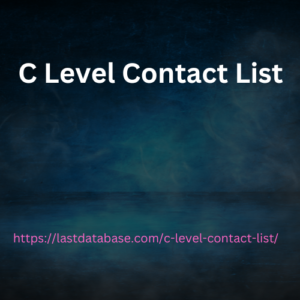Post by account_disabled on Dec 19, 2023 8:02:19 GMT
You don't have to download it, it takes up much less space, and uses device features (camera, geolocation, notifications, gesture navigation). It is said that this type of apps will replace the various apps that many of us currently have on our phone screens over time. Considering the advantages mentioned above, this is not surprising at all. Market giants like Google (who developed ) and Microsoft have seen this. You can now find maps and on . From an e-commerce point of view it looks even more interesting, since there are now tools available (for example on ) that can somehow transform your store into such an application.
For this purpose, notification modules etc. are used. How does it work? When a potential C Level Contact List customer visits an online store where this module is installed, he will be asked if he would like to receive notifications from this module. Once consent is confirmed, the customer's mobile browser will listen for notifications from the store. Your task is to determine what message content he will receive at the time you specify. This could be information about new products in the store, promotions or competitions. In addition, you can send individual subscribers information about the performance of their orders (for example, information about parcel shipments.

When such a message is sent, a push notification (in the form of a system notification from the browser, e.g. ). Users can also add links to such apps to their phone screens, giving them immediate access, for example to their store account. Beware of fake emails from the tax office! A few days ago, a rather disturbing email appeared in my mailbox, with a title that screamed to me about an intention to initiate a financial audit. A well-known agency appears in the sender field: Tax Agency. It later turned out that many people in Poland received such an email that day. Here's what it says: The tax bureau read out a notice of intention to initiate an audit on day, month, year.
For this purpose, notification modules etc. are used. How does it work? When a potential C Level Contact List customer visits an online store where this module is installed, he will be asked if he would like to receive notifications from this module. Once consent is confirmed, the customer's mobile browser will listen for notifications from the store. Your task is to determine what message content he will receive at the time you specify. This could be information about new products in the store, promotions or competitions. In addition, you can send individual subscribers information about the performance of their orders (for example, information about parcel shipments.

When such a message is sent, a push notification (in the form of a system notification from the browser, e.g. ). Users can also add links to such apps to their phone screens, giving them immediate access, for example to their store account. Beware of fake emails from the tax office! A few days ago, a rather disturbing email appeared in my mailbox, with a title that screamed to me about an intention to initiate a financial audit. A well-known agency appears in the sender field: Tax Agency. It later turned out that many people in Poland received such an email that day. Here's what it says: The tax bureau read out a notice of intention to initiate an audit on day, month, year.
